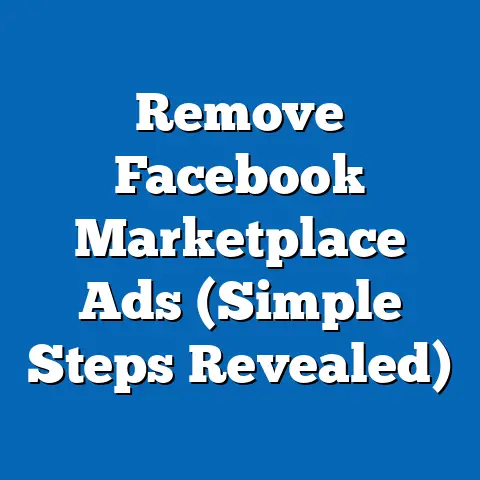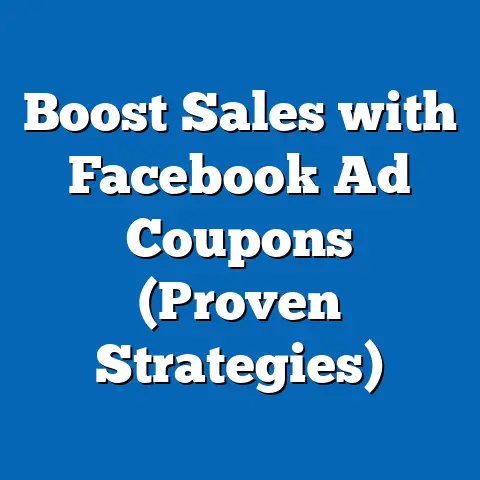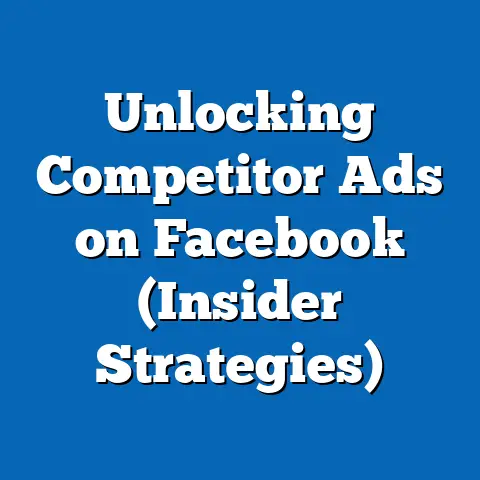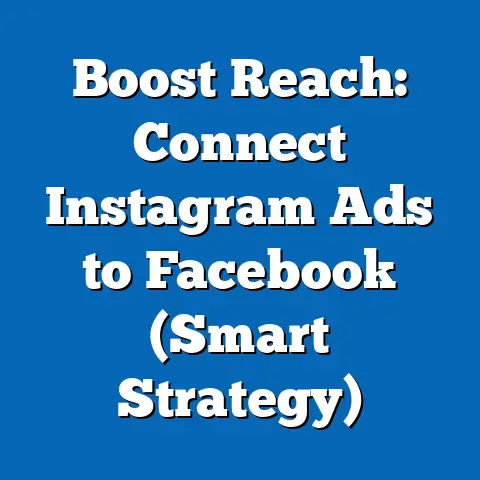Boost Facebook Ads with Browser Add-Ons (Strategic Tips)
Boost Facebook Ads with Browser Add-Ons: Strategic Tips for Maximizing Your ROI
Imagine two scenarios. In the first, you’re running Facebook ads, but it feels like you’re throwing darts in the dark. You’re not sure what’s working, what’s not, and your budget is slowly dwindling. Now, picture this: you’re armed with a set of powerful browser add-ons that give you x-ray vision into your competitors’ strategies, help you craft captivating visuals, and provide real-time insights to optimize your campaigns.
(Insert contrasting image here: One side shows a dimly lit, chaotic room with someone blindly throwing darts. The other side shows a brightly lit, organized space with someone strategically aiming with precision tools.)
The difference is night and day, right? In today’s fiercely competitive digital marketplace, Facebook advertising isn’t just an option; it’s often a necessity. However, simply having a presence isn’t enough. You need to be strategic, data-driven, and resourceful. Browser add-ons can be your secret weapon, offering a range of functionalities that can streamline your processes, unlock valuable insights, and ultimately, boost your return on investment (ROI).
The Importance of Facebook Ads in Digital Marketing
Facebook, with its billions of active users, is a goldmine for advertisers. It’s not just a social platform; it’s a massive marketing ecosystem. I remember when Facebook ads first started gaining traction. It felt like the Wild West – everyone was rushing in, trying to figure out how to make it work. Now, it’s a much more sophisticated landscape, but the potential is still immense.
Currently, Facebook boasts over 2.9 billion monthly active users (Meta Q1 2024 Report). That’s a staggering number, and it represents a diverse audience with varying interests, demographics, and purchasing behaviors. This vast reach makes Facebook an ideal platform for businesses of all sizes to connect with their target audience.
According to recent statistics, Facebook ads can generate an average ROI of $3.26 for every $1 spent (Source: Hubspot). While this number can vary depending on your industry, target audience, and ad strategy, it highlights the potential profitability of Facebook advertising.
Whether you’re a small business owner looking to increase brand awareness or a large corporation aiming to drive sales, Facebook ads can play a crucial role in your digital marketing strategy. They allow you to target specific demographics, interests, and behaviors, ensuring that your message reaches the right people at the right time.
However, the sheer volume of content on Facebook can make it challenging to stand out. Think about it: users are bombarded with countless posts, ads, and updates every day. To capture their attention, your ads need to be visually appealing, highly relevant, and strategically targeted. That’s where browser add-ons come in. They provide the tools and insights you need to create compelling ads that cut through the noise and deliver results.
Key Takeaway: Facebook advertising offers unparalleled reach and targeting capabilities, but success requires a strategic approach and the right tools.
Understanding Browser Add-Ons
So, what exactly are browser add-ons, and how do they work? Simply put, browser add-ons (also known as extensions) are small software programs that enhance the functionality of your web browser. They’re like apps for your browser, adding features and capabilities that aren’t built-in.
Think of it like this: your browser is a basic car, and add-ons are the upgrades you can install to make it faster, more efficient, and more enjoyable to drive. You can add a GPS navigation system, a premium sound system, or even a turbocharger. Similarly, browser add-ons can add a wide range of functionalities to your browser, from ad blocking to password management to social media integration.
Popular browsers like Chrome, Firefox, Safari, and Edge all support add-ons. Each browser has its own app store (e.g., Chrome Web Store, Firefox Add-ons) where you can browse and install add-ons.
The benefits of using browser add-ons are numerous. They can:
- Increase productivity: Automate repetitive tasks, streamline workflows, and save time.
- Enhance security: Protect your privacy, block malicious websites, and manage passwords securely.
- Customize your browsing experience: Tailor your browser to your specific needs and preferences.
- Provide valuable insights: Access data and analytics that can inform your decisions and improve your performance.
For Facebook advertisers, browser add-ons can be particularly valuable. They can help you analyze competitors’ ads, track your ad performance, create eye-catching visuals, and optimize your ad copy. In the following sections, I’ll explore some of the key browser add-on categories that can significantly enhance your Facebook advertising efforts.
Key Takeaway: Browser add-ons are small software programs that enhance the functionality of your web browser, offering a wide range of benefits for Facebook advertisers.
Key Browser Add-Ons for Enhancing Facebook Ads
Now, let’s get to the good stuff: the specific browser add-ons that can transform your Facebook advertising game. I’ve categorized these add-ons based on their primary functions to make it easier for you to find the tools that best suit your needs.
3.1. Ad Blockers
You might be thinking, “Why would I, as an advertiser, use an ad blocker?” It seems counterintuitive, right? But trust me, ad blockers can be incredibly useful for analyzing your competitors’ ads without the distraction of irrelevant content.
Imagine scrolling through your Facebook feed, trying to focus on the ads that your competitors are running, but you’re constantly bombarded with other ads, posts, and updates. It can be overwhelming and difficult to stay focused. That’s where ad blockers come in.
By blocking all other ads, ad blockers allow you to focus solely on the ads that your competitors are running. This can give you valuable insights into their targeting strategies, ad copy, and visual creative.
Some popular ad blockers include:
- AdBlock: A widely used ad blocker that blocks all types of ads, including pop-ups, banners, and video ads.
- Adblock Plus: Another popular ad blocker that offers customizable filtering options.
- uBlock Origin: A lightweight and efficient ad blocker that uses minimal resources.
How to use ad blockers effectively:
- Install an ad blocker: Choose an ad blocker that suits your needs and install it on your browser.
- Disable the ad blocker on your own website: You don’t want to block your own ads, so make sure to disable the ad blocker on your website.
- Browse Facebook and analyze competitor ads: Scroll through your Facebook feed and pay attention to the ads that your competitors are running.
- Take notes on their targeting strategies, ad copy, and visual creative: What are they doing well? What could they improve?
I remember when I first started using ad blockers to analyze competitor ads. I was amazed at how much I could learn simply by focusing on their ads without the distraction of other content. It helped me identify trends, understand their targeting strategies, and improve my own ad campaigns.
Key Takeaway: Ad blockers can be a valuable tool for analyzing competitor ads, providing insights into their targeting strategies, ad copy, and visual creative.
3.2. Analytics Tools
Data is the lifeblood of any successful advertising campaign. Without data, you’re just guessing. Analytics tools provide the insights you need to track your ad performance, understand your audience, and optimize your ad spend.
There are several browser add-ons that can help you with Facebook ad analytics:
- Facebook Pixel Helper: This official Facebook add-on helps you verify that your Facebook pixel is installed correctly and firing properly. It can also help you troubleshoot any issues with your pixel implementation. I’ve used this countless times to ensure my pixel is tracking conversions accurately. A misconfigured pixel can lead to inaccurate data and wasted ad spend.
- SimilarWeb: This add-on provides insights into website traffic, engagement metrics, and audience demographics. It can help you understand your competitors’ website performance and identify potential targeting opportunities.
- WhatRuns: This add-on identifies the technologies and platforms used by a website. It can help you understand what tools your competitors are using and identify potential opportunities to improve your own website.
How to use analytics tools effectively:
- Install the analytics tools: Choose the analytics tools that suit your needs and install them on your browser.
- Verify your Facebook pixel implementation: Use the Facebook Pixel Helper to ensure that your pixel is installed correctly and firing properly.
- Track your ad performance: Monitor your key metrics, such as impressions, clicks, conversions, and ROI.
- Analyze your data: Look for trends and patterns in your data. What’s working? What’s not?
- Optimize your ad spend: Adjust your targeting, ad copy, and visual creative based on your data analysis.
I once worked with a client who was struggling to generate leads from their Facebook ads. After installing the Facebook Pixel Helper, I discovered that their pixel was not firing correctly on their landing page. This meant that they were not tracking conversions accurately and were wasting a significant portion of their ad spend. Once we fixed the pixel implementation, their lead generation improved dramatically.
Key Takeaway: Analytics tools provide the insights you need to track your ad performance, understand your audience, and optimize your ad spend.
3.3. Design Tools
Visuals are crucial for capturing attention and engaging your audience on Facebook. Your ad creative needs to be eye-catching, relevant, and aligned with your brand. Fortunately, there are several browser add-ons that can help you create stunning visuals for your Facebook ads.
- Canva: This popular design tool offers a wide range of templates, graphics, and fonts that you can use to create professional-looking visuals. Canva also has a browser add-on that allows you to easily access your Canva designs from any website. I rely on Canva for quick and easy ad creation. It’s a lifesaver when I need to whip up a compelling visual on the fly.
- ColorZilla: This add-on allows you to identify the exact color code of any element on a webpage. It can be useful for ensuring that your ad visuals are consistent with your brand colors.
- Awesome Screenshot: This add-on allows you to capture screenshots of webpages and annotate them with text, arrows, and other elements. It can be useful for creating mockups of your ad designs or providing feedback to your design team.
Tips on using design tools to enhance ad creativity and engagement:
- Use high-quality images and videos: Your visuals should be clear, crisp, and visually appealing.
- Use your brand colors and fonts: Consistency is key for building brand recognition.
- Use compelling headlines and text overlays: Your visuals should tell a story and capture the viewer’s attention.
- Test different visuals: Experiment with different images, videos, and text overlays to see what resonates best with your audience.
- Keep it simple: Don’t overcrowd your visuals with too much information.
I’ve seen countless examples of ads that failed simply because the visuals were poor quality or irrelevant. Investing in good design is essential for creating ads that stand out and drive results.
Key Takeaway: Design tools can help you create stunning visuals for your Facebook ads, enhancing ad creativity and engagement.
3.4. SEO and Keyword Tools
While Facebook ads allow you to target specific demographics and interests, using relevant keywords in your ad copy can further improve your ad performance. SEO and keyword tools can help you identify trending keywords and topics that are relevant to your target audience.
- Keywords Everywhere: This add-on shows you the search volume, cost-per-click, and competition data for keywords on Google, YouTube, and other websites. It can help you identify high-volume, low-competition keywords that you can use in your ad copy.
- MozBar: This add-on provides insights into the SEO performance of websites, including domain authority, page authority, and backlinks. It can help you understand your competitors’ SEO strategies and identify potential opportunities to improve your own website’s SEO.
- Ubersuggest: This add-on provides keyword suggestions, content ideas, and competitor analysis. It can help you brainstorm new ad copy ideas and identify potential targeting opportunities.
How to use SEO and keyword tools to optimize ad copy:
Key Takeaway: SEO and keyword tools can help you identify trending keywords and topics that are relevant to your target audience, allowing you to optimize your ad copy for better performance.
3.5. Social Media Management Tools
Managing multiple Facebook ad campaigns can be time-consuming and overwhelming. Social media management tools can help you streamline your workflow, automate repetitive tasks, and analyze your ad performance in one place.
- Buffer: This tool allows you to schedule posts, analyze your social media performance, and manage multiple social media accounts. It can help you streamline your posting schedule and ensure that your ads are running at the optimal times.
- Hootsuite: This tool offers similar features to Buffer, but it also includes advanced analytics and reporting capabilities. It can help you track your ad performance, identify trends, and optimize your ad spend.
- Sprout Social: This tool is designed for larger businesses and agencies. It offers a wide range of features, including social listening, customer relationship management, and team collaboration.
How to use social media management tools to manage ad campaigns efficiently:
- Choose a social media management tool that suits your needs: Consider your budget, the number of social media accounts you need to manage, and the features you require.
- Connect your Facebook ad account: Connect your Facebook ad account to the social media management tool.
- Schedule your posts: Schedule your posts in advance to ensure that your ads are running at the optimal times.
- Analyze your ad performance: Track your key metrics, such as impressions, clicks, conversions, and ROI.
- Adjust your ad strategy based on your data analysis: If your ads are not performing well, adjust your targeting, ad copy, and visual creative.
Using a social media management tool can save you a significant amount of time and effort. It allows you to manage your ad campaigns more efficiently and focus on other important tasks.
Key Takeaway: Social media management tools can help you streamline your workflow, automate repetitive tasks, and analyze your ad performance in one place, allowing you to manage your ad campaigns more efficiently.
Strategic Tips for Using Browser Add-Ons with Facebook Ads
Now that you’re familiar with some of the key browser add-ons for Facebook advertising, let’s discuss some strategic tips for using them effectively.
4.1. Setting Clear Goals
Before you start using any browser add-ons, it’s important to define your campaign objectives. What do you want to achieve with your Facebook ads? Do you want to increase brand awareness, generate leads, drive sales, or something else?
Once you’ve defined your goals, you can select the browser add-ons that will help you achieve them. For example, if you want to increase brand awareness, you might focus on using design tools to create visually appealing ads and analytics tools to track your reach and engagement. If you want to generate leads, you might focus on using SEO and keyword tools to optimize your ad copy and analytics tools to track your conversion rate.
I always tell my clients, “Start with the ‘why’ before you worry about the ‘how’.” Knowing your objectives will guide your entire strategy, including your choice of browser add-ons.
4.2. Experimenting with Different Tools
There are countless browser add-ons available, and not all of them will be a good fit for your needs. It’s important to experiment with different tools to find what works best for you.
Try out different ad blockers, analytics tools, design tools, SEO and keyword tools, and social media management tools. See which ones you find most useful and which ones provide the most valuable insights.
Don’t be afraid to try new tools and technologies. The digital marketing landscape is constantly evolving, and you need to stay up-to-date with the latest trends and best practices.
4.3. Integrating Add-Ons into Daily Workflow
Once you’ve found the browser add-ons that work best for you, it’s important to integrate them into your daily workflow. Make sure to use them consistently and regularly.
For example, you might start your day by analyzing your ad performance using analytics tools. Then, you might use SEO and keyword tools to brainstorm new ad copy ideas. Next, you might use design tools to create visually appealing ads. Finally, you might use a social media management tool to schedule your posts and manage your ad campaigns.
By integrating browser add-ons into your daily workflow, you can streamline your processes, save time, and improve your ad performance.
4.4. Analyzing Data and Adjusting Strategies
Data is the key to success in Facebook advertising. You need to constantly analyze your data to see what’s working and what’s not.
Use analytics tools to track your key metrics, such as impressions, clicks, conversions, and ROI. Look for trends and patterns in your data. What’s working? What’s not?
Based on your data analysis, adjust your targeting, ad copy, and visual creative. Experiment with different strategies and see what delivers the best results.
Remember, Facebook advertising is an iterative process. You need to constantly test, measure, and adjust your strategies to optimize your ad performance.
4.5. Staying Updated with Trends
The digital marketing landscape is constantly changing. New browser add-ons are being released all the time, and existing add-ons are being updated with new features and capabilities.
It’s important to stay up-to-date with the latest trends and best practices. Read industry blogs, attend webinars, and follow social media influencers to stay informed.
By staying updated with trends, you can ensure that you’re using the most effective tools and strategies to maximize your ROI.
Key Takeaway: Strategic use of browser add-ons involves setting clear goals, experimenting with different tools, integrating them into your daily workflow, analyzing data, and staying updated with trends.
Case Studies and Real-World Examples
To illustrate the power of browser add-ons, let’s take a look at some case studies and real-world examples.
Case Study 1: E-commerce Business Increases Sales by 30%
An e-commerce business that sells handmade jewelry was struggling to generate sales from their Facebook ads. They were using basic targeting and ad copy, but their ads were not resonating with their target audience.
After installing the Keywords Everywhere add-on, they discovered that their target audience was searching for specific types of jewelry, such as “boho earrings” and “vintage necklaces.” They incorporated these keywords into their ad copy, and their click-through rate and conversion rate improved dramatically.
They also used the Canva add-on to create more visually appealing ads. They used high-quality images of their jewelry and added compelling headlines and text overlays. As a result, their sales increased by 30% in just one month.
Case Study 2: Local Restaurant Generates 50 New Leads
A local restaurant wanted to generate more leads from their Facebook ads. They were using basic targeting and ad copy, but their ads were not generating many leads.
After installing the Facebook Pixel Helper, they discovered that their pixel was not firing correctly on their landing page. This meant that they were not tracking conversions accurately and were wasting a significant portion of their ad spend.
Once they fixed the pixel implementation, their lead generation improved dramatically. They also used the SimilarWeb add-on to analyze their competitors’ website traffic and identify potential targeting opportunities. As a result, they generated 50 new leads in just one week.
Real-World Example: Marketing Agency Streamlines Workflow
A marketing agency that manages Facebook ad campaigns for multiple clients was struggling to keep up with the workload. They were spending too much time on repetitive tasks, such as scheduling posts and analyzing ad performance.
After installing Buffer and Hootsuite, they were able to streamline their workflow and automate many of their repetitive tasks. They were also able to analyze their ad performance in one place, which saved them a significant amount of time and effort.
As a result, they were able to manage more clients and increase their revenue.
These case studies and real-world examples demonstrate the power of browser add-ons for enhancing Facebook advertising. By using the right tools and strategies, you can significantly improve your ad performance and achieve your business goals.
Key Takeaway: Real-world examples and case studies highlight the tangible benefits of using browser add-ons to improve Facebook ad performance.
Conclusion
In conclusion, browser add-ons can be a game-changer for your Facebook advertising efforts. They offer a range of functionalities that can streamline your processes, unlock valuable insights, and ultimately, boost your ROI.
From ad blockers that help you analyze competitor ads to analytics tools that track your ad performance, design tools that create stunning visuals, SEO and keyword tools that optimize your ad copy, and social media management tools that streamline your workflow, browser add-ons are an essential component of any successful Facebook advertising strategy.
By setting clear goals, experimenting with different tools, integrating them into your daily workflow, analyzing data, and staying updated with trends, you can maximize the benefits of browser add-ons and achieve your business goals.
Don’t be afraid to embrace these technologies and make them a critical part of your advertising strategy. The digital marketing landscape is constantly evolving, and you need to stay ahead of the curve to succeed.
Remember, it’s not just about throwing money at ads; it’s about working smarter, not harder. Browser add-ons can help you do just that.
Call to Action
So, what are you waiting for? Start exploring and integrating browser add-ons into your Facebook ad campaigns today! The sooner you start, the sooner you’ll see the results.
Take the time to research different add-ons, experiment with different strategies, and find what works best for your unique needs.
The possibilities are endless, and the potential rewards are significant. With the right tools and strategies, you can transform your Facebook advertising and achieve your business goals.
Go forth and conquer the world of Facebook advertising! I’m confident that with the knowledge and tools you’ve gained from this article, you’ll be well on your way to success. Good luck!






